Pratt & Whitney Twin Wasp (R-1830)
Compiled by Kimble D. McCutcheon
Published 24 Apr 2020; Revised 30 Jun 2022
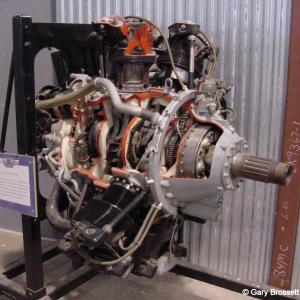
Pratt & Whitney R-1830
(Gary Brossett) |
Pratt & Whitney began work on a two-row radial in late 1929. The experimental 14-cylinder R-2270, built mostly from Wasp and Hornet parts, first ran on 14 May 1930. This engine was developed into the Twin Wasp, also a 14-cylinder two-row radial. The Twin Wasp first ran on 16 Apr 1931 and the first production engine was delivered to the U.S. Navy on 9 Nov 1932.
With a takeoff rating that, depending on model, ranged from 630 to 1,350 hp, The Twin Wasp was chosen to power numerous aircraft designs, most notably the Consolidated B-24, Douglas DC-3 and C-47, and Grumman F4F.
Pratt & Whitney and its licensees produced 173,618 Twin Wasps between 1932 and 1951, more than any other aircraft engine.
|
Twin Wasp Description
Type = 14-cylinder, two-row, air-cooled, radial
Bore = 5.500" Stroke = 5.500" Displacement = 1,829.4 in³
Cylinders are built up of cast aluminum heads with integral valve mechanism housings, screwed and shrunk onto forged steel cylinder barrel having integral fins. Exhaust ports contain shrunk-in stainless steel liners providing slip joints with the steel exhaust pipes. Aluminum bronze intake valve seats and steel exhaust seats are shrunk into the head. Pressure baffles are provided to supply uniform cylinder cooling in all flight conditions.
Forged aluminum pistons are ribbed on the head undersides and skirt insides for strength and additional cooling. Each piston has three compression rings, one oil scraper ring and one dual oil control ring.
Each master rod, with detachable cap and lead-silver bearing, has six "I" section articulated rods attached with knuckle pins. Each articulated rod has bronze bushings at both piston and knuckle pin ends.
The two-throw one-piece crankshaft is supported by three roller bearings in crankcase sections, and located by the front main bearing. The propeller shaft is supported within the crankshaft by a lead-copper pilot bearing and in the nose section by a deep groove ball bearing, which absorbs propeller thrust.
The crankcase is made up of six sections. The power section parts are forged from aluminum and machined together. The nose section houses reduction gears and, in geared versions, has provision for a Hamilton Standard hydromatic full feathering or other controllable propeller. A drilled oil passage in upper part of nose section provides a means for operating the propeller pitch control. The power sections are joined by through bolts. The blower section is bolted to the power section, contains the supercharger and carries bronze-bushed, forged-steel engine mount lugs. The blower intermediate section is bolted to the blower section, supports the downdraft carburetor and houses the impeller gear train. An accessory section of new design is bolted to the blower intermediate section.
Exhaust valves are sodium-cooled and faced with stellite. There is one intake and one exhaust valve per cylinder, which are actuated by ball bearing rocker arms and push rods of heat-treated aluminum alloy with hardened steel ball ends. Two shelf-mounted cams, one in the front power section and one in the rear, are driven by spur reduction gears directly off the crankshaft at one-eighth crankshaft speed. All the valve gear, including the push rods, is completely enclosed and oil tight. Internally drilled passages provide lubrication for push rods and rocker arm bearings.
The induction system consists of one Stromberg injection carburetor with automatic mixture control, idle cutoff, primer tubing and distributor, from which the charge passes through vanes in intermediate rear sections to the supercharger, through diffuser and induction passages, providing uniform distribution and contributing to improved performance at high altitudes.
A supercharger, in this case single-stage, single-speed, employs a large diameter impeller of improved design carried by high capacity ball bearings and driven by dual intermediate gears containing spring-type flexible couplings to absorb shocks and to equalize driving loads.
Ignition is provided by two Scintilla flange-mounted magnetos each of which operates an independent set of spark plugs through a single radio-shielded ignition manifold that is attached to the power section front. This simplifies maintenance and provides the shortest possible leads.
Lubrication is provided by a gear-type oil pump with a separate low pressure section to the accessory drives in the rear regulated by an independent low pressure relief valve. Inter-rocker box and inter-cylinder drain pipes connect to a separate sump from which the return oil is scavenged by a pump in the nose.
The planetary reduction bevel gears are of Pratt & Whitney design and have a 0.7625 ratio.
All accessories are grouped in the rear and are driven through an intermediate gear train by a single drive shaft spline fitted to the crankshaft rear. Provision is made to drive two-gun synchronizers or auxiliary accessory pumps, two magnetos, two tachometers, vacuum pump, oil pump, fuel pump, starter and generator. The generator drive may be used as a 30 hp takeoff for a remote accessory gear box. Pressure lubrication through drilled passages is provided for vacuum pump drive and gun synchronizer or auxiliary drives.
Pratt & Whitney Twin Wasp
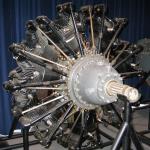 |
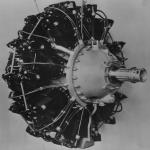 |
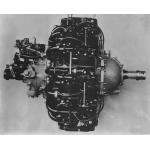 |
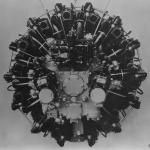 |
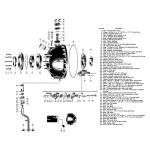 |
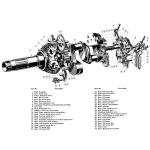 |
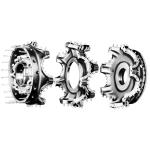 |
| Pratt & Whitney R-2270 |
Twin Wasp |
Twin Wasp |
Twin Wasp |
Nose Case |
Gear Train |
Crankcase |
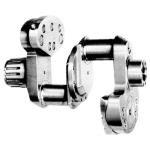 |
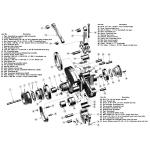 |
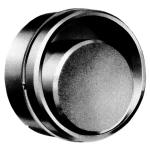 |
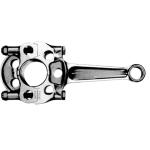 |
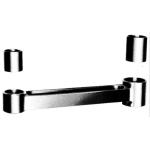 |
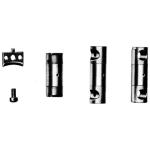 |
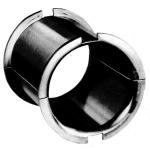 |
| Crankshaft |
Crankshaft |
Salomon Tuned
Vibration Absorber |
Master Rod |
Articulated Rod |
Knuckle Pins and Lock |
Master Rod Bearing |
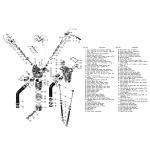 |
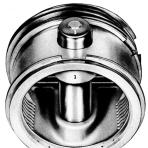 |
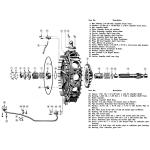 |
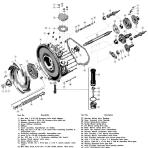 |
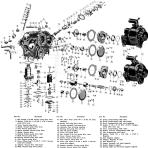 |
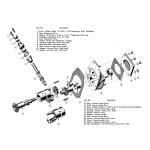 |
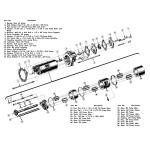 |
| Cylinder Assembly |
Piston |
Blower Section |
Blower Drive |
Accessory Section |
Side Auxiliary Drive |
Oil Pressure Pump |
R-1830 Engine Manufacture at Buick
R-1830 Reduction Gear Manufacture at Buick
R-1830 Cylinder Head Manufacture at Buick
R-1830 Foundry Pattern and Die Work at Buick
R-1830 Machining and Assembly, Buick, Melrose, Illinois





















